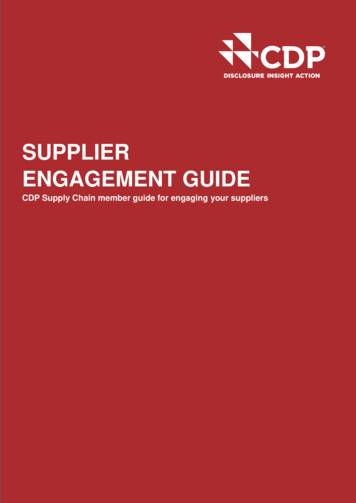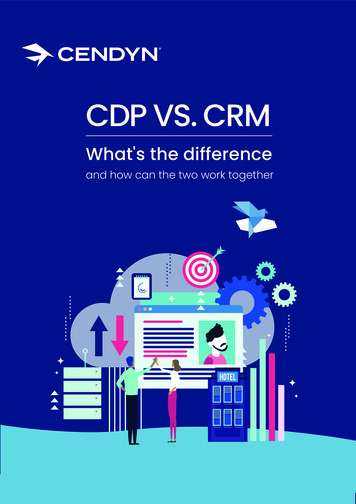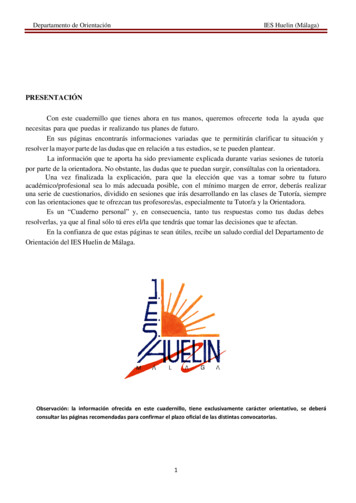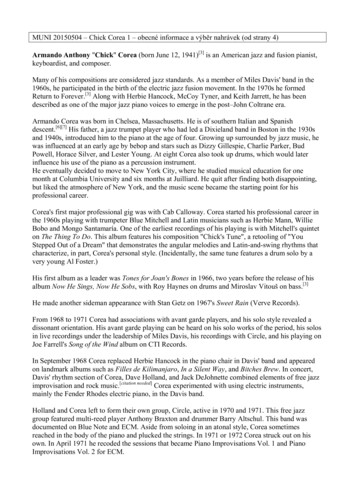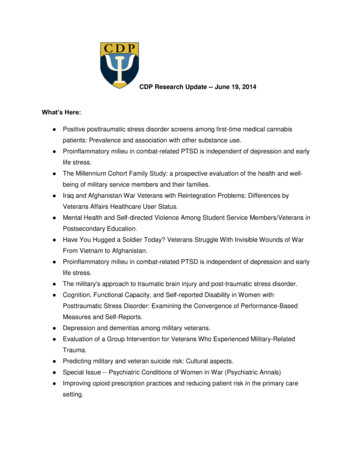
Transcription
CDP Research Update -- June 19, 2014What’s Here: Positive posttraumatic stress disorder screens among first-time medical cannabispatients: Prevalence and association with other substance use. Proinflammatory milieu in combat-related PTSD is independent of depression and earlylife stress. The Millennium Cohort Family Study: a prospective evaluation of the health and wellbeing of military service members and their families. Iraq and Afghanistan War Veterans with Reintegration Problems: Differences byVeterans Affairs Healthcare User Status. Mental Health and Self-directed Violence Among Student Service Members/Veterans inPostsecondary Education. Have You Hugged a Soldier Today? Veterans Struggle With Invisible Wounds of WarFrom Vietnam to Afghanistan. Proinflammatory milieu in combat-related PTSD is independent of depression and earlylife stress. The military's approach to traumatic brain injury and post-traumatic stress disorder. Cognition, Functional Capacity, and Self-reported Disability in Women withPosttraumatic Stress Disorder: Examining the Convergence of Performance-BasedMeasures and Self-Reports. Depression and dementias among military veterans. Evaluation of a Group Intervention for Veterans Who Experienced Military-RelatedTrauma. Predicting military and veteran suicide risk: Cultural aspects. Special Issue -- Psychiatric Conditions of Women in War (Psychiatric Annals) Improving opioid prescription practices and reducing patient risk in the primary caresetting.
RCT of a Brief Phone-Based CBT Intervention to Improve PTSD Treatment Utilization byReturning Service Members. A meta-analysis of group cognitive behavioral therapy for insomnia. Sleep timing, chronotype, mood, and behavior at an Arctic latitude (69 N). Cognitive Behavior Therapy for Insomnia: State of the Science or a Stated Science? The acute cognitive effects of zopiclone, zolpidem, zaleplon, and eszopiclone: Asystematic review and meta-analysis. Risk Pathways Among Traumatic Stress, Posttraumatic Stress Disorder Symptoms, andAlcohol and Drug Problems: A Test of Four Hypotheses. Temporal Stability of DSM-5 Posttraumatic Stress Disorder Criteria in a ProblemDrinking Sample. The protective role of compassion satisfaction for therapists who work with sexualviolence survivors: an application of the broaden-and-build theory of positive emotions. Are hippocampal size differences in posttraumatic stress disorder mediated by sleeppathology? Current Pharmacological Interventions in Panic Disorder. Reduced Specificity in Episodic Future Thinking in Posttraumatic Stress Disorder. Military traumatic brain injury: A review. Military-related traumatic brain injury and neurodegeneration. Physiological Correlates of Insomnia. Cognitive processing therapy for posttraumatic stress disorder delivered to ruralveterans via telemental health: a randomized noninferiority clinical trial. The Relationship Between Postconcussive Symptoms and Quality of Life in VeteransWith Mild to Moderate Traumatic Brain Injury. Evaluation of the Military Functional Assessment Program: Preliminary Assessment ofthe Construct Validity Using an Archived Database of Clinical Data. Parental Injury and Psychological Health of Children. A Prospective Study of Suicidal Ideation in Posttraumatic Stress Disorder: The Role ofPerceptions of Defeat and Entrapment. The effect of support on internet-delivered treatment for insomnia: does baselinedepression severity matter? "Killing Two Birds with One Stone": Alcohol Use Reduction Interventions with PotentialEfficacy in Enhancing Self-Control.
Assessing treatment integrity in cognitive-behavioral therapy: comparing sessionsegments with entire sessions. Combined Medication and CBT for Generalized Anxiety Disorder With African AmericanParticipants: Reliability and Validity of Assessments and Preliminary Outcomes. Examination of the core cognitive components of cognitive behavioral therapy andacceptance and commitment therapy: an analogue investigation. Iraq and Afghanistan War Veterans with Reintegration Problems: Differences byVeterans Affairs Healthcare User Status. Cognitive Processing Therapy for Veterans With Posttraumatic Stress Disorder: AComparison Between Outpatient and Residential Treatment. Aerobic Exercise Reduces Symptoms of Posttraumatic Stress Disorder: A RandomizedControlled Trial. Social Reactions to Sexual Assault Disclosure, Coping, Perceived Control and PTSDSymptoms in Sexual Assault Victims. Anticipating the traumatic brain injury-related health care needs of women veterans afterthe Department of Defense change in combat assignment policy. Connecting combat-related mild traumatic brain injury with posttraumatic stress disordersymptoms through brain imaging. Intermittent explosive disorder: Associations with PTSD and other Axis I disorders in aUS military veteran sample. Implementing brief cognitive behavioral therapy in primary care: A pilot study. Measuring chronic pain intensity among veterans in a residential rehabilitation treatmentprogram. Diagnostic performance of the PTSD checklist and the Vietnam Era Twin Registry PTSDscale. Links of Interest Resource of the Week: Center for the Study of Traumatic Stress -- Resource 8Addict Behav. 2014 Jun 2;39(10):1414-1417. doi: 10.1016/j.addbeh.2014.05.022. [Epub aheadof print]Positive posttraumatic stress disorder screens among first-time medical cannabispatients: Prevalence and association with other substance use.
Bohnert KM, Perron BE, Ashrafioun L, Kleinberg F, Jannausch M, Ilgen MATwenty-one states and the District of Columbia have passed legislation allowing for the use ofmedical cannabis for those individuals with qualifying medical conditions, which includeposttraumatic stress disorder (PTSD) for a growing number of states. Little information isavailable regarding PTSD among medical cannabis patients. This study seeks to provide initialdata on this topic by examining the prevalence and correlates of positive PTSD screens amonga sample of patients seeking medical cannabis certification for the first time (n 186). Twentythree percent (42/186; 95% confidence interval [CI] 17%-29%) of the patients in the studysample screened positive for PTSD. Moreover, the group that screened positive for PTSD hadhigher percentages of lifetime prescription opioid, cocaine, prescription sedative, and streetopioid use, as well as a higher percentage of recent prescription sedative use, than the groupthat screened negative for PTSD. These findings highlight the relatively common use of othersubstances among medical cannabis patients with significant PTSD symptoms, even whencompared with other patients seeking medical cannabis for the first time. As a growing numberof states include PTSD among the list of qualifying medical conditions for medical cannabis,additional research is needed to better characterize the longitudinal relationship betweenmedical cannabis use and PTSD symptoms. Published by Elsevier 5Brain Behav Immun. 2014 Jun 11. pii: S0889-1591(14)00166-4. doi: 10.1016/j.bbi.2014.06.003.[Epub ahead of print]Proinflammatory milieu in combat-related PTSD is independent of depression and earlylife stress.Lindqvist D, Wolkowitz OM, Mellon S, Yehuda R, Flory JD, Henn-Haase C, Bierer LM, AbuAmara D, Coy M, Neylan TC, Makotkine I, Reus VI, Yan X, Taylor NM, Marmar CR, DhabharFSBACKGROUND:Chronic inflammation may be involved in combat-related Post-Traumatic Stress Disorder(PTSD) and may help explain comorbid physical diseases. However, the extent to which combatexposure per se, depression, or early life trauma, all of which are associated with combatPTSD, may confound the relationship between PTSD and inflammation is unclear.METHODS:We quantified interleukin (IL)-6, IL-1β, tumor necrosis factor (TNF)-α, interferon (IFN)-γ, and Creactive protein (CRP) in 51 combat-exposed males with PTSD and 51 combat-exposed maleswithout PTSD, and assessed PTSD and depression severity as well as history of early life
trauma. To decrease the possibility of Type I errors, we summed standardized scores of IL-1β,IL-6, TNFα, IFNγ and CRP into a total "pro-inflammatory score." PTSD symptom severity wasassessed with the Clinician Administered PTSD Scale (CAPS) rating scale.RESULTS:Subjects with PTSD had significantly higher pro-inflammatory scores compared to combatexposed subjects without PTSD (p 0.006), and even after controlling for early life trauma,depression diagnosis and severity, body mass index, ethnicity, education, asthma/allergies, timesince combat and the use of possibly confounding medications (p 0.002). Within the PTSDgroup, the pro-inflammatory score was not significantly correlated with depressive symptomseverity, CAPS total score, or with the number of early life traumas.CONCLUSIONS:Combat-related PTSD in males is associated with higher levels of pro-inflammatory cytokines,even after accounting for depression and early life trauma. These results, from one of thelargest studies of inflammatory cytokines in PTSD to date, suggest that immune activation maybe a core element of PTSD pathophysiology more so than a signature of combat exposurealone. Copyright 2014. Published by Elsevier /mpr.1446/abstractThe Millennium Cohort Family Study: a prospective evaluation of the health and wellbeing of military service members and their families.Crum-Cianflone, N. F., Fairbank, J. A., Marmar, C. R. and Schlenger, W.International Journal of Methods in Psychiatric ResearchArticle first published online: 10 JUN 2014The need to understand the impact of war on military families has never been greater thanduring the past decade, with more than three million military spouses and children affected bydeployments to Operations Iraqi Freedom and Enduring Freedom. Understanding the impact ofthe recent conflicts on families is a national priority, however, most studies have examinedspouses and children individually, rather than concurrently as families. The Department ofDefense (DoD) has recently initiated the largest study of military families in US military history(the Millennium Cohort Family Study), which includes dyads of military service members andtheir spouses (n 10,000). This study includes US military families across the globe withplanned follow-up for 21 years to evaluate the impact of military experiences on families,including both during and after military service time. This review provides a comprehensivedescription of this landmark study including details on the research objectives, methodology,survey instrument, ancillary data sets, and analytic plans. The Millennium Cohort Family Study
offers a unique opportunity to define the challenges that military families experience, and toadvance the understanding of protective and vulnerability factors for designing training andtreatment programs that will benefit military families today and into the future. Copyright 2014John Wiley & Sons, 10488-014-0564-2/fulltext.htmlIraq and Afghanistan War Veterans with Reintegration Problems: Differences by VeteransAffairs Healthcare User Status.Sayer NA, Orazem RJ, Noorbaloochi S, Gravely A, Frazier P, Carlson KF, Schnurr PP, OlesonHAdministration and Policy in Mental Health and Mental Health Services Research2014 Jun 11. [Epub ahead of print]We studied 1,292 Iraq and Afghanistan War veterans who participated in a clinical trial ofexpressive writing to estimate the prevalence of perceived reintegration difficulty and compareVeterans Affairs (VA) healthcare users to nonusers in terms of demographic and clinicalcharacteristics. About half of participants perceived reintegration difficulty. VA users andnonusers differed in age and military background. Levels of mental and physical problems werehigher in VA users. In multivariate analysis, military service variables and probable traumaticbrain injury independently predicted VA use. Findings demonstrate the importance of researchcomparing VA users to nonusers to understand veteran healthcare 80/07448481.2014.931282Mental Health and Self-directed Violence Among Student Service Members/Veterans inPostsecondary Education.John R. Blosnich, Marek S. Kopacz, Janet McCarten, Robert M. BossarteJournal of American College HealthAccepted author version posted online: 11 Jun 2014Objectives:Using a sample of student service members/veterans, the current study aimed to examine theprevalence of psychiatric diagnoses and suicide-related outcomes and the association ofhazardous duty with mental health.
Participants:Data are from the Fall 2011 National College Health Assessment (n 27,774). Methods:Logistic regression was used to examine (1) the association of student service member/veteranstatus with mental health outcomes and (2) the association of hazardous duty with mentalhealth outcomes among student service members/veterans (n 706).Results:Student service members/veterans had higher odds of self-harm than students without militaryexperience. Among student service members/veterans, hazardous duty was positivelyassociated (OR 2.00, 95% CI: 1.30–3.07) with having a psychiatric diagnosis but negativelyassociated (OR 0.41, 95% CI: 0.20–0.85) with suicidal ideation.Conclusions:Self-harm may be a unique phenomenon among service members/veterans. Suicide preventionwith this population should include information about self-harm, and future research shouldexplore whether suicidal intent underlies tory theses/12/Have You Hugged a Soldier Today? Veterans Struggle With Invisible Wounds of WarFrom Vietnam to Afghanistan.Gabe MoraDissertation/ThesisBachelor of Arts in HistoryUniversity of Puget SoundSpring 5-18-2014The misinformation about Post-traumatic stress disorder (PTSD) in American society has leadto the stigmatization and discrimination of veterans since the war in Vietnam. PTSD was not aformal diagnosis until 1980, resulting in negative public perception of veterans suffering with thismental illness. Even today as research and information about the disorder has becomeincreasingly available to the public, veterans of the Iraq and Afghanistan wars are facing thesame discrimination's as the veterans of Vietnam during their transitions back to civilian life.-----
0889159114001664Proinflammatory milieu in combat-related PTSD is independent of depression and earlylife stress.Daniel Lindqvist, Owen M. Wolkowitz, Synthia Mellon, Rachel Yehuda, Janine D. Flory, ClareHenn-Haase, Linda M. Bierer, Duna Abu-Amara, Michelle Coy, Thomas C. Neylan, IouriMakotkine, Victor I. Reus, Xiaodan Yan, Nicole M. Taylor, Charles R. Marmar, Firdaus S.DhabharBrain, Behavior, and ImmunityAvailable online 12 June 2014BackgroundChronic inflammation may be involved in combat-related post-traumatic stress disorder (PTSD)and may help explain comorbid physical diseases. However, the extent to which combatexposure per se, depression, or early life trauma, all of which are associated with combatPTSD, may confound the relationship between PTSD and inflammation is unclear.MethodsWe quantified interleukin (IL)-6, IL-1β, tumor necrosis factor (TNF)-α, interferon (IFN)-γ, and Creactive protein (CRP) in 51 combat-exposed males with PTSD and 51 combat-exposed maleswithout PTSD, and assessed PTSD and depression severity as well as history of early lifetrauma. To decrease the possibility of Type I errors, we summed standardized scores of IL-1β,IL-6, TNFα, IFNγ and CRP into a total “pro-inflammatory score”. PTSD symptom severity wasassessed with the Clinician Administered PTSD Scale (CAPS) rating scale.ResultsSubjects with PTSD had significantly higher pro-inflammatory scores compared to combatexposed subjects without PTSD (p 0.006), and even after controlling for early life trauma,depression diagnosis and severity, body mass index, ethnicity, education, asthma/allergies, timesince combat and the use of possibly confounding medications (p 0.002). Within the PTSDgroup, the pro-inflammatory score was not significantly correlated with depressive symptomseverity, CAPS total score, or with the number of early life traumas.ConclusionsCombat-related PTSD in males is associated with higher levels of pro-inflammatory cytokines,even after accounting for depression and early life trauma. These results, from one of thelargest studies of inflammatory cytokines in PTSD to date, suggest that immune activation maybe a core element of PTSD pathophysiology more so than a signature of combat exposurealone.-----
ng.aspx?articleid 1880674The military's approach to traumatic brain injury and post-traumatic stress disorder.Geoffrey S. F. Ling, Jamie Grimes, James M. EcklundUniformed Services Univ. of the Health Sciences (United States)Proc. SPIE 9112, Sensing Technologies for Global Health, Military Medicine, and EnvironmentalMonitoring IV, 91120J (June 5, 2014); doi:10.1117/12.2058740Traumatic brain injury (TBI) and Post Traumatic Stress Disorder (PTSD) are commonconditions. In Iraq and Afghanistan, explosive blast related TBI became prominent among USservice members but the vast majority of TBI was still due to typical causes such as falls andsporting events. PTS has long been a focus of the US military mental health providers. CombatStress Teams have been integral to forward deployed units since the beginning of the GlobalWar on Terror. Military medical management of disease and injury follows standard of careclinical practice guidelines (CPG) established by civilian counterparts. However, when civilianCPGs do not exist or are not applicable to the military environment, new practice standards arecreated. Such is the case for mild TBI. In 2009, the VA-DoD CPG for management of mildTBI/concussion was published and a system-wide clinical care program for mild TBI/concussionwas introduced. This was the first large scale effort on an entire medical care system to addressall severities of TBI in a comprehensive organized way. In 2010, the VA-DoD CPG formanagement of PTSD was published. Nevertheless, both TBI and PTS are still incompletelyunderstood. Investment in terms of money and effort has been committed by the DoD to theirstudy. The Defense and Veterans Brain Injury Center, National Intrepid Center of Excellenceand the Defense Centers of Excellence for Psychological Health and Traumatic Brain Injury areprominent examples of this effort. These are just beginnings, a work in progress ready toleverage advances made scientifically and always striving to provide the very best care to itsmilitary beneficiaries. (2014) COPYRIGHT Society of Photo-Optical InstrumentationEngineers (SPIE). Downloading of the abstract is permitted for personal use cle/pii/S0022395614001708Cognition, Functional Capacity, and Self-reported Disability in Women withPosttraumatic Stress Disorder: Examining the Convergence of Performance-BasedMeasures and Self-Reports.Joanna L. Kaye, Boadie W. Dunlop, Dan V. Iosifescu, Sanjay J. Mathew, Mary E. Kelley, PhilipD. Harvey
Journal of Psychiatric ResearchAvailable online 12 June 2014Individuals with posttraumatic stress disorder (PTSD) experience cognitive impairments anddisability in everyday activities. In other neuropsychiatric disorders, impairments in cognition andfunctional capacity (i.e., the ability to perform everyday tasks) are associated with impairmentsin real-world functioning, independent of symptom severity. To date, no studies of functionalcapacity have been conducted in PTSD. Seventy-three women with moderate to severe PTSDunderwent assessment with measures of cognition (MATRICS Consensus Cognitive Battery:MCCB), functional capacity (UCSD Performance-Based Skills Assessment-Brief: UPSA-B),PTSD (Clinician-Administered PTSD Scale and PTSD Symptom Scale–Self-report (PSS-SR)),and depression (Montgomery Asberg Depression Rating Scale). Patients also reported theirsubjective level of disability (Sheehan Disability Scale). Over-reporting of symptom severity wasassessed using six validity items embedded within the PSS-SR. Results indicated that onaverage PTSD patients manifested mild impairments on the functional capacity measure,performing about 1/3 standard deviation below healthy norms, and similar performance on theMCCB. Both clinician-rated and self-rated PTSD symptom severity correlated with self-reporteddisability but not with functional capacity. Self-reported disability did not correlate with functionalcapacity or cognition. Greater self-reported disability, depression, and PTSD symptoms allcorrelated with higher scores on the PSS-SR validity scale. The divergence between objectiveand subjective measures of disability suggests that individuals’ distress, as indexed by symptomvalidity measures, may be impacting self-reports of disability. Future studies of disability shouldincorporate objective measures in order to obtain a broad perspective on ce/article/pii/S1552526014001356Depression and dementias among military veterans.Amy L. Byers, Kristine YaffeAlzheimer's & DementiaVolume 10, Issue 3, Supplement, June 2014, Pages S166–S173Military Risk SupplementDepression is very common throughout the course of veterans' lives, and dementia is commonin late life. Previous studies suggest an association between depression and dementia inmilitary veterans. The most likely biologic mechanisms that may link depression and dementiaamong military veterans include vascular disease, changes in glucocorticoid steroids andhippocampal atrophy, deposition of β-amyloid plaques, inflammatory changes, and alterations ofnerve growth factors. In addition, military veterans often have depression comorbid with
posttraumatic stress disorder or traumatic brain injury. Therefore, in military veterans, thesehypothesized biologic pathways going from depression to dementia are more than likelyinfluenced by trauma-related processes. Treatment strategies for depression, posttraumaticstress disorder, or traumatic brain injury could alter these pathways and as a result decreasethe risk for dementia. Given the projected increase of dementia, as well as the projectedincrease in the older segment of the veteran population, in the future, it is critically important thatwe understand whether treatment for depression alone or combined with other regimensimproves cognition. In this review, we summarize the principal mechanisms of this relationshipand discuss treatment implications in military 0.1521/ijgp.2014.64.3.367Evaluation of a Group Intervention for Veterans Who Experienced Military-RelatedTrauma.Daniel W. Cox, Marvin J. Westwood, Stuart M. Hoover, Eric K. H. Chan, Carson A. Kivari,Michael R. Dadson, and Bruno D. ZumboInternational Journal of Group Psychotherapy: Vol. 64, No. 3, pp. 367-380Military-related trauma and veteran status have been linked with posttraumatic stresssymptoms, depressive symptoms, and other personal and interpersonal difficulties. While manytreatment evaluations for people with posttraumatic stress exist, few veteran populations orgroup formats have been evaluated. This report presents an evaluation of the VeteransTransition Program (VTP)–a group-based treatment for veterans who experienced a militaryrelated trauma that is negatively impacting their lives. Fifty-six veterans attended the VTP; allattended every session and completed pre- and post-tests assessing posttraumatic stress anddepressive symptoms. Significant pre- to post-test improvement was found on all scales. Thesefindings demonstrate the potential benefit of the VTP and encourage further research.----http://www.ling.uni-potsdam.de/ koller/aclpub/W14-32/book.pdf#page 13Predicting military and veteran suicide risk: Cultural aspects.Paul Thompson, Craig Bryan, Chris PoulinACL 2014 Workshop on Computational Linguistics and Clinical PsychologyThe Association for Computational Linguistics
This paper describes the three phases of the Durkheim Project. For this project we developed aclinician's dashboard that displays output of models predicting suicide risk of veterans andactive duty military personnel. During phase one, we built the clinician’s dashboard and completed a Veterans Affairs (VA) predictive risk medical records study, based on an analysis of thenarrative, or free text, portions of VA medical records, In phase two, we will predict suicide riskbased on opt-in social media postings by patients using social media websites, e.g., Facebook.We describe the software infrastructure that we have completed for this phase two system.During phase three we will provide a three layer intervention strategy. We discuss ourmethodology for the three phases, including IRB-approved protocols for the first two phases anda soon-to-be approved IRB protocol for phase /past-issues?year 04ee2cc5-1b5e-470b-91344d923e23103b&pissue 9b07ad21-b441-41f2-99ca-972fda7bef93Psychiatric AnnalsApril 2014Volume 44 · Issue 4Special Issue -- Psychiatric Conditions of Women in WarTable of ContentsEditorialWomen at War and a Brief Review of the Augmenting Effects of L-Methylfolate on DepressionJan Fawcett, MDCase ChallengeSudden-Onset Behavioral Disturbance in a Woman with No Prior Psychiatric, Medical HistoryNilesh S. Tannu, MD; Olaoluwa O. Okusaga, MD, MScPHRGuest EditorialThis issue: Health Issues for Female Service Members in the “Long War”Elspeth Cameron Ritchie, MD, MPHOverview of Physical and Mental Health Issues: Women at WarElspeth Cameron Ritchie, MD, MPHIntimate Partner Violence and Military WomenGlenna Tinney, MSW, ACSW, DCSWSuicide Risk among Military WomenMarjan Ghahramanlou-Holloway, PhD; Jennifer Tucker, PhD; Laura L. Neely, PsyD; Jaime T.
Carreno-Ponce, PhD; Katheryn Ryan, MPH; Kathryn Holloway, MA; Brianne George, MAFeatureThe Role and Postulated Biochemical Mechanism of L-Methylfolate Augmentation in MajorDepression: A Case-ReportPat Rabjohn, MD, t-peer-reviewed-article-JPRImproving opioid prescription practices and reducing patient risk in the primary caresetting.Martin D Cheatle, Cody BarkerJournal of Pain ResearchPublished Date June 2014 Volume 2014:7 Pages 301 - 311Chronic pain is complex, and the patient suffering from chronic pain frequently experiencesconcomitant medical and psychiatric disorders, including mood and anxiety disorders, and insome cases substance use disorders. Ideally these patients would be referred to aninterdisciplinary pain program staffed by pain medicine, behavioral health, and addictionspecialists. In practice, the majority of patients with chronic pain are managed in the primarycare setting. The primary care clinician typically has limited time, training, or access toresources to effectively and efficiently evaluate, treat, and monitor these patients, particularlywhen there is the added potential liability of prescribing opioids. This paper reviews the role ofopioids in managing chronic noncancer pain, including efficacy and risk for misuse, abuse, andaddiction, and discusses several models employing novel technologies and health deliverysystems for risk assessment, intervention, and monitoring of patients receiving opioids in aprimary care 33496Psychiatr Serv. 2014 Jun 16. doi: 10.1176/appi.ps.201300433. [Epub ahead of print]RCT of a Brief Phone-Based CBT Intervention to Improve PTSD Treatment Utilization byReturning Service Members.Stecker T, McHugo G, Xie H, Whyman K, Jones M
OBJECTIVESMany service members do not seek care for mental health and addiction problems, often withserious consequences for them, their families, and their communities. This study tested theeffectiveness of a brief, telephone-based, cognitive-behavioral intervention designed to improvetreatment engagement among returning service members who screened positive forposttraumatic stress disorder (PTSD).METHODSService members who had served in Operation Enduring Freedom or Operation Iraqi Freedomwho screened positive for PTSD but had not engaged in PTSD treatment were recruited(N 300), randomly assigned to either control or intervention conditions, and administered abaseline interview. Intervention participants received a brief cognitive-behavioral therapyintervention; participants in the control condition had access to usual services. All participantsreceived follow-up phone calls at months 1, 3, and 6 to assess symptoms and service utilization.RESULTSParticipants in both conditions had comparable rates of treatment engagement and PTSDsymptom reduction over the course of the six-month trial, but receiving the telephone-basedintervention accelerated service utilization (treatment engagement and number of sessions) andPTSD symptom reduction.CONCLUSIONSA one-time brief telephone intervention can engage service members in PTSD treatment earlierthan conventional methods and can lead to immediate symptom reduction. There were nodifferences at longer-term follow-up, suggesting the need for additional intervention to buildupon initial 811Sleep Med Rev. 2014 May 14. pii: S1087-0792(14)00048-3. doi: 10.1016/j.smrv.2014.05.001.[Epub ahead of print]A meta-analysis of group cognitive behavioral therapy for insomnia.Koffel EA, Koffel JB, Gehrman PRInsomnia is the most common sleep disorder among the general population. Although cognitivebehavioral therapy for insomnia (CBT-I) is the psychological treatment of choice, the availabilityof individual therapy is often not suff
characteristics. About half of participants perceived reintegration difficulty. VA users and nonusers differed in age and military background. Levels of mental and physical problems were higher in VA users. In multivariate analysis, military service variables and probable traumatic brain injury independently predicted VA use.
